|
Articles Darjeeling to Jaisalmer by Dick Brafford I've traveled to India many times, and every time I get off the plane, I feel like I'm at home. When I flew into New Delhi, I found a cheap room in the lively area called the Paharganj next to the bazaar. Once, New Delhi was a city of royal power. Then it became the seat of colonial power. Later it was the seat of bureaucratic power. Today New Delhi still remains the center of power and is emerging as an important center for corporations and the computer industry. (Look out, Western world, these people are smart and will work hard for a few dollars a day!)
I passed by India Gate, a memorial inscribed with the names of the valiant Indian soldiers who lay down their lives in World War I. The green, velvety lawns at India Gate are a popular gathering place for people of all age groups. I also visited the Red Fort, called Qila-i-Mubarakin, in Old Delhi. The Fort was constructed in 1639, when Shah Jahan decided to shift his capital to New Delhi from Agra. The building has had quite a glorious history: It witnessed the magnificence of the Royal Court, the splendor and the fall of the Mughals, British rule, and finally the dawn of Indian independence. Even today, the building still retains a sense of lost glory.
One of big stars of Bhangra is Daler Mehndi. He trained under Ustad Rahat Ali Khan, from whom he learned to master Hindustani classical music. Mehndi's training is very evident when he sings. In 1991 he formed his own group and by 1995 had a hit album, "Bolo Ta Ra Ra," which broke all records. His upbeat style of singing is very appealing, and his Bollywood videos, which feature him dancing and singing with beautiful women, are real hoots. Download a Daler mp3 patte chak deyange I wanted to see the Himalayas, so I headed
by train to Siliguri, the last city before you head up through
the mountains to The next day I hired a driver with a van and
headed on to Darjeeling, about 8,000 feet at the top of the foothills.
This city owes its grandeur to its natural beauty, its clean The mountains awaken first with a tentative peeking of the sun. A steep ride, five kilometers from Ghoom, or an invigorating walk up a steep incline, leads mountain worshippers to Tiger Hill. The air is chilly in the darkness, but to the east, a dull orange sun emerges in the sky. The snow-capped Everest, Kabru, Kanchenjunga, Jannu and other peaks slowly emerge from slumber to start a new day. Mountain worshippers gasp at the magnificent sight. As the fog lifts and the sun slowly penetrates, the town gradually comes alive amidst the scent of freshly brewing tea.
On top of a peak near the town of Pelling, I visited one of the kingdom's oldest monasteries, Sanga Choling, which can only be reached by foot. While climbing up the mountain, I looked out over the giant Himalayas rising up over 29,000 feet. Once inside the house of chants and prayers, I took a picture of a bodhisattva statue, which is the Buddhist ideal of the saviour figure, along with a wall that was covered with hundreds of 17th-Century handpainted Buddhas. I was the only tourist there and had the place to myself. I had planned to go to Thailand but decided
against it because I was running up a big bill. Instead, I caught
a local flight on India Airlines back to Delhi, hired a driver
and headed out to the Golden City of Jaisalmer, which lies courageously
at the This desert city lies on an old trade route that connects India to Central Asia. It is an important tourist destination today, famous for camel rides across the Thar Desert and its golden sand dunes. It is a city of forts and palaces. It has neighboring Pakistan on its western side, the beautiful city of Bikaner to the south, and Jodphur, the Blue City of Tradition, borders on the east.
Jaisalmer Fort was founded by the Rajputs in 1156. The Jain temple, made between the 12th and 15th Centuries, bears testimony to Rajasthan's unique artistry.
Photo credits by Richard Brafford, shot during this last trip to India 2003, except for Daler Mehndi, which was taken from DalerMehndi.com |
|
|
Copyright©EighthSquare.com
P.O. Box 580, New York, NY 10113 ©2003
|

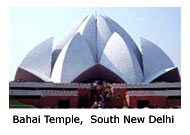 One
of New Delhi's most important sites is the Bahai Temple/Lotus
Temple, situated in South New Delhi. Modeled after the Sydney
Opera House, it is shaped like a lotus flower. It is an eye-catching
yet serene edifice that is worth exploring.
One
of New Delhi's most important sites is the Bahai Temple/Lotus
Temple, situated in South New Delhi. Modeled after the Sydney
Opera House, it is shaped like a lotus flower. It is an eye-catching
yet serene edifice that is worth exploring.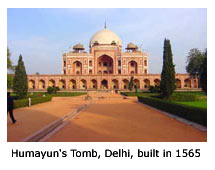 After
lunch I visited Humayun's Tomb, one of my favorite tourist sites.
It was commissioned by Humayun's wife, Haji, nine years after
his death and designed by a Persian architect named Mirak Mirza
Ghiyas. Completed in 1565, the edifice was a trendsetter of the
time and a major influence for the Taj Mahal a century later.
After
lunch I visited Humayun's Tomb, one of my favorite tourist sites.
It was commissioned by Humayun's wife, Haji, nine years after
his death and designed by a Persian architect named Mirak Mirza
Ghiyas. Completed in 1565, the edifice was a trendsetter of the
time and a major influence for the Taj Mahal a century later.
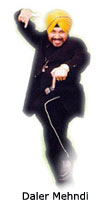 I
took a break from being a scholarly tourist by shopping for CDs
of popular and traditional styles of Indian music, especially
Bhangra. Bhangra is believed to have existed in some form or another
in India since the 15th Century, when farmers celebrated the grain
harvest by dancing to drumbeats and sometimes singing. Bhangra
has been influenced by Western pop music; its raw sound has fused
with house, rap, techno, disco, reggae, even jungle music. It
is still sung in the Punjabi language, and singers typically add
nonsensical, random noises.
I
took a break from being a scholarly tourist by shopping for CDs
of popular and traditional styles of Indian music, especially
Bhangra. Bhangra is believed to have existed in some form or another
in India since the 15th Century, when farmers celebrated the grain
harvest by dancing to drumbeats and sometimes singing. Bhangra
has been influenced by Western pop music; its raw sound has fused
with house, rap, techno, disco, reggae, even jungle music. It
is still sung in the Punjabi language, and singers typically add
nonsensical, random noises.  Darjeeling
on a 36-hour train ride. I read and visited with other passengers
to pass the time. I arrived in Siliguri on the day of the colorful
Saraswatsi Festival, which honors this celebrated goddess of knowledge.
Darjeeling
on a 36-hour train ride. I read and visited with other passengers
to pass the time. I arrived in Siliguri on the day of the colorful
Saraswatsi Festival, which honors this celebrated goddess of knowledge. fresh
mountain air and above all, the smiling, hardy people for whom
it is home. Known for its natural splendor, Darjeeling's best
gift to visitors is the view.
fresh
mountain air and above all, the smiling, hardy people for whom
it is home. Known for its natural splendor, Darjeeling's best
gift to visitors is the view. 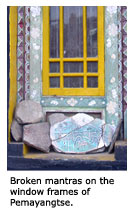 From
here I traveled to the Kingdom of Sikkim. What I find most fascinating
is the voyage itself. Sikkim is a daydream that one can realize
and enjoy; it is a state masked in the mystery of seclusion, far
away from the insanity
From
here I traveled to the Kingdom of Sikkim. What I find most fascinating
is the voyage itself. Sikkim is a daydream that one can realize
and enjoy; it is a state masked in the mystery of seclusion, far
away from the insanity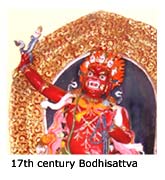 of the modern world. Located in the Eastern Himalayas, it is bound
by China in the north, West Bengal India in the south, Bhutan
in the east and Nepal in the west. The state is spread below Mount
Kanchanjunga, the third highest peak in the world. The locals
worship the mountain as a protecting deity.
of the modern world. Located in the Eastern Himalayas, it is bound
by China in the north, West Bengal India in the south, Bhutan
in the east and Nepal in the west. The state is spread below Mount
Kanchanjunga, the third highest peak in the world. The locals
worship the mountain as a protecting deity. 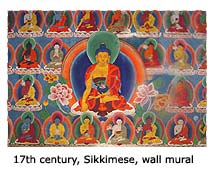 I
watched a monk pray, then circle the monastery clockwise as he
held burning incense. This ritual of circling the Buddha was formed
at the caves of Ajanta in the 2nd Century BC, and it is one of
the oldest continued traditions in Buddhism today. As the smoke
rises up, it takes the prayer to heaven. While going down the
mountain, along the trail of prayer flags that blew in the wind,
I looked out in wonder at a captivating landscape. Here, the side
of the mountain drops about 6,000 feet to the valley floor below.
Beyond, more mountains rise and go on for as far as the eye can
see in any direction.
I
watched a monk pray, then circle the monastery clockwise as he
held burning incense. This ritual of circling the Buddha was formed
at the caves of Ajanta in the 2nd Century BC, and it is one of
the oldest continued traditions in Buddhism today. As the smoke
rises up, it takes the prayer to heaven. While going down the
mountain, along the trail of prayer flags that blew in the wind,
I looked out in wonder at a captivating landscape. Here, the side
of the mountain drops about 6,000 feet to the valley floor below.
Beyond, more mountains rise and go on for as far as the eye can
see in any direction. western
end of India in the state of Rajasthan.
western
end of India in the state of Rajasthan. The
rays of the setting sun draw a heavenly picture on the sands of
Jaisalmer. The magnificent wood and stone-carved mansions and
buildings display the love the Rajputs had for the Fine Arts.
The
rays of the setting sun draw a heavenly picture on the sands of
Jaisalmer. The magnificent wood and stone-carved mansions and
buildings display the love the Rajputs had for the Fine Arts. My
last days spent in the warm desert were just what I needed
before returning home to New York and the reality of my life.
The digital pictures I took are a great reminder that India is
more than just a vacation.
My
last days spent in the warm desert were just what I needed
before returning home to New York and the reality of my life.
The digital pictures I took are a great reminder that India is
more than just a vacation.